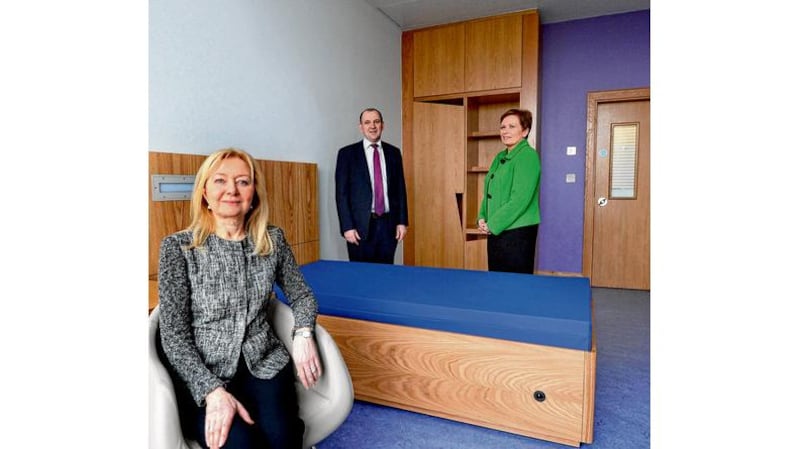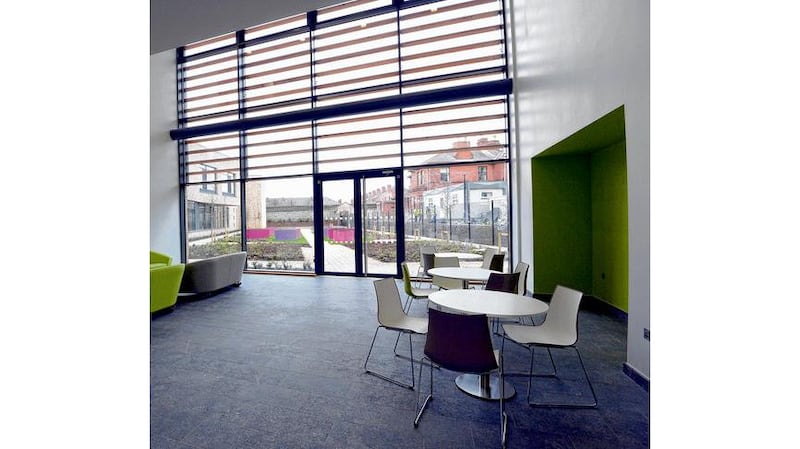The opening of the Phoenix Care Centre is a sign that the days of the ‘granite building on the hill’ are coming to an end
You make your way in through a light-filled foyer, down the underfloor-heated corridor and into what looks like a health spa.
In the distance is a landscaped courtyard surrounded by glass walls, egg pod-style chairs in bright primary colours and bedrooms with sturdy oak furniture. It might not look like it, but this is the State’s newest acute mental health facility.


The Phoenix Care Centre on Dublin’s North Circular Road formally opens its doors on Thursday, replacing the antiquated St Brendan’s Hospital in Grangegorman which has operated for the past 199 years. The remainder of the 75-acre site will be redeveloped as a campus for the Dublin Institute of Technology.
It’s quite a contrast. The €22 million, 54-bed care centre is equipped with en-suite bathrooms and has access to private gardens, with a roof-top terrace that looks out towards the Dublin mountains. It’s as if the service has jumped from the 19th century, straight into the 21st century, skipping over the 20th along the way.
Sense of space
“There were times when we never thought we’d see this day,” admits Dr Margo Wrigley, executive clinical director. “You can see the openness and the light. Everything here is designed around giving people a sense of space. The big thing is helping people get back home as soon as possible – and this will help with that process.”
Over the coming weeks the last remaining 30 patients from St Brendan’s will transfer into the new unit. It will be a daunting process for some, who have been resident in the institution for anything up to 20 or 30 years. To help ease the transition, medical staff have been giving patients tours of the new centre.
The reaction, they say, has been a mixture of enthusiasm and unease. Some are fearful of change and worry they won’t have access to a sprawling campus anymore; others are looking forward to having privacy and modern facilities.
The remainder of beds will be for those with the most severe forms of mental ill-health whose needs can’t be met in the community or in the local acute unit of a hospital. This intensive care service will treat people with severe illnesses – such as acute episodes of schizophrenia or the manic phase of bi-polar affective disorder – which require specialist intervention.
Typically, patients will stay between four and six weeks, before returning to their acute units or homes to complete their rehabilitation. The old days of long-term admissions, say staff, are largely over.
“For people with severe behavioural disorders, that settles very quickly, so admissions tend to be relatively short,” says Dr Roy Browne, clinical director. “Being able to provide treatment is much easier in an open area where you don’t have people crashing into each other.”
Safety first
A closer look at the centre reveals how it has been modified to ensure patients are kept safe.
Some of the bedroom furniture and fitted wardrobes have slanted, ligature-resistant sides rather than straight edges; the pod-style chairs are soft to touch but difficult to move; the wide corridors are aimed at preventing patients bumping into each other; the glass walls allow staff to unobtrusively monitor patients; .
It’s a troubling reminder that despite the light and airy feel, many of those admitted may be in real distress.
For Martin Rogan, the Health Service Executive’s head of mental health services, the opening of the centre is another sign that the days of the “granite building on the hill” are coming to an end.
The vast majority of the 22 out-dated mental institutions which dominated towns and cities across the State have now either ceased accepting admissions or closed altogether. Some have already been converted into other uses such as hotels – as is the case in Sligo – or education centres – like in Castlebar and, shortly, Grangegorman. The focus of treatment is now very much based in the community.
“We’ve come a long way from the days when a person went to the doctor with their suitcase. The majority of new referrals to mental health services don’t go anywhere near a psychiatric hospital.
“Today, 90 per cent of people who go to the GP with a mental health problem don’t go beyond that. The 10 per cent attend specialist services around the State. And 10 per cent of that group are admitted to hospital. And 10 per cent of those are involuntarily detained.”
Against their will
Rogan says the widely held perception about mental health – that people spend long periods of time in grim institutions against their will – has yet to catch up with reality. “They spent 150 years looming over towns. They had an intimidating and threatening place. It was where parents would threaten to send the children if they didn’t behave. It’s not a surprise they’re seared into the public imagination that way. But as these new facilities open, all of that will begin to fade away with time.”
But there are still major challenges for mental health services. Budgets are being cut back, demand for assistance is rising, and services in the community are patchy, to say the least. Patient groups say the medical model still tends to dominate over talk therapy and other forms of rehabilitation. Most agree we have a long way to go before we realise the vision of a recovery-based mental health service.
Back at the Phoenix Care Centre, staff are counting down the days to the official opening on Thursday.
There is relief. But there is also a feeling that the negative connotations that surround Grangegorman doesn’t do full justice to the efforts of nurses and medical staff down through the years.
“I think people always battled to try to offer the very best of care here,” says Dr Wrigley. “There were boarding-out schemes a century ago and occupational therapy was introduced in the 1930s. Then, the really big breakthrough came with medications which helped.”
But the ever-present problem, she says, was the condition of the place. Now, this is about to change.“No matter how skilled your staff are, if you’re in a grotty environment, it will have its downside. So, we’re very confident that we have the components right here. We’re very excited by this. It really is the missing link.”
Status of old psychiatric institutions
After decades of promises, most of the old-style mental hospitals have now either closed or ceased taking new admissions.
St Brendan’s, Dublin (1814): Closes Feb 28th, 2013
St Ita’s, Dublin (1902): Closed to new admissions
St Loman’s, Dublin (1950): Closed
Central Mental Hospital, Dundrum: Open
Newcastle, Wicklow (1896): Open
St Dymphna’s, Carlow, (1832): Closed to admissions
St Loman’s, Westmeath (1855): Closing this year
St Finnian’s, Laois (1833): Open
St Canice’s, Kilkenny (1852): Closed (small psychiatry of old age unit on campus)
St Luke’s, Tipperary (1834): Closed (small psychiatry of old age unit on campus)
St Senan’s, Wexford (1868): Closed (small psychiatry of old age unit on campus)
St Otteran’s, Waterford (1835): Closed
Our Lady’s, Cork (1852): Closed
St Stephen’s, Cork (1950): Open
St Finan’s, Kerry (1852): Closed to admissions; new facility due next year
St Joseph’s, Limerick (1827): Closed to admissions
Our Lady’s, Clare (1868): Closed
St Brigid’s, Ballinasloe (1833): Closed
St Mary’s, Castlebar (1866): Closed
St Patrick’s, Roscommon (1940): Closed
St Columba’s, Sligo (1855): Closed
St Conal’s, Donegal (1866): Closed
St Davnet’s, Monaghan (1869): Closed to admissions; small continuing care unit on campus
St Brigid’s, Louth (1935): Open










